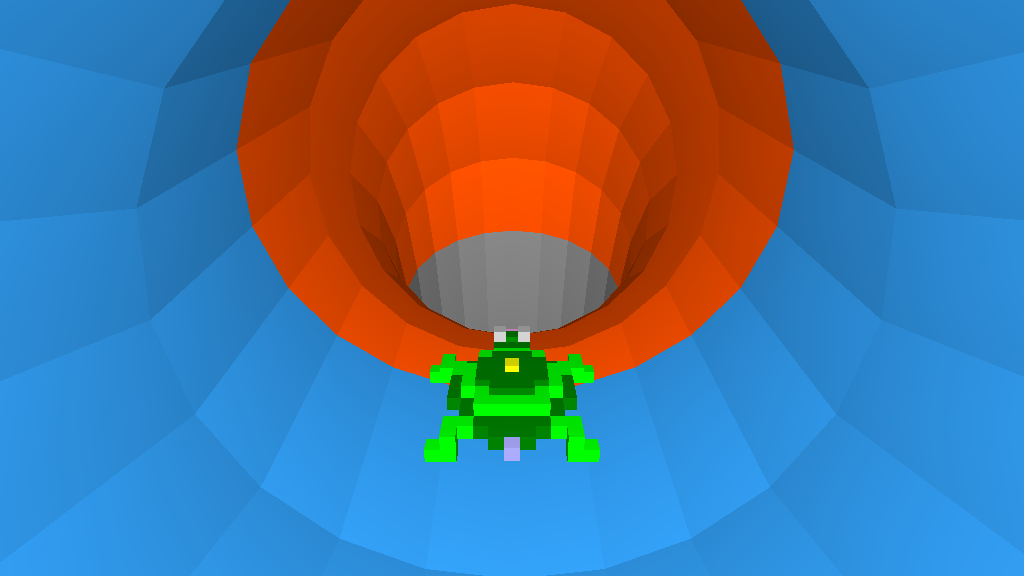
One-a-Day: Space Tube Ride using TUBE and TUBEARC

Myrtle creates a 3D space tube ride for her to fly through…
Sometimes Myrtle needs to take a break and have a little fun! One of the things she can do is make a space tube and fly through it, using the TUBE and TUBEARC primitives:
TUBE makes a straight tube, and takes the parameters <radius> <depth> and <sides>. So, tube 20 10 10 makes a tube with a radius of 20 turtle units, a depth of 10 turtle units and 10 sides.
TUBEARC creates a curved tube, and takes the parameters <thickness> (the radius of the tube itself) <radius> (the radius of the arc itself) <sides> <totalsegments> and <arcsegments> – the last two are the total segments that would make up a complete torus, or donut, and the number of segments we actually want to create. So values of 20 and 10 will create a half-donut: tubearc 10 20 20 20 10
There are four procedures to our space tube program: createcourse, drawcourse, followcourse and spacetube.
createcourse generates the data that represents the tube’s course. It creates a course made up of 100 segments, represented by a word made up of a series of numbers between 0 and 4, where 0 represents a straight section of tube, and 1 to 4 represent four directions of turn. We use dountil to ensure we don’t repeat the same direction of turn more than once and end up looping back on ourself. Although, createcourse is not perfect and it is still possible for the course to cross over itself – but it’s a good thing tube walls aren’t solid!
drawcourse creates the graphical representation of the contents of the :course container we generated using createcourse. We use the twosided primitive to generate reflective “normals” on both sides of the shapes we generate from that point forward, and we use randfc to set a random ‘fill color’ or shape color for each segment as we create them.
We use foreach to step through each segment listed in the :course container, creating either a tube or a tubearc where appropriate.
While tubes are created directly under Myrtle, tubearcs are created around her, and so this means we need to do a bit of calisthenics to position the tubearcs where they need to go. Follow them through one command at a time to see how they work! We wait 2 / 60ths of a second between each segment creation so we can follow it.
followcourse causes Myrtle to fly through the created course, once again iterating through the :course container using foreach. fluid causes Myrtle to move forward smoothly, and to turn through the arcs we use a repeat. sleep is another form of wait, which takes milliseconds as a parameter instead of wait‘s 60ths of a second.
setpremodel allows us to ‘prepend’ commands to the turtle’s model, allowing us to make Myrtle look like she’s turning the appropriate way as she moves through the course.
Finally, spacetube puts it all together and is the procedure we execute to create the maze and fly through it. spacetube performs a reset, turns off the text layer, tells Snappy (the camera turtle) to pull away from Myrtle 1000 turtle units, tells Snappy to ‘follow’ Myrtle (turn to face her when she disappears from his view), then executes the createcourse procedure, the drawcourse procedure, sets the view (camera) turtle to Myrtle, turns Myrtle’s ‘light’ on (so we can see properly inside the tubes), turns Snappy’s light off, sets the camera ‘view point’ of Myrtle a bit up and behind her, and then executes followcourse.
TO spacetube
reset
fullscreen
snappy:pullout 1000
snappy:follow "myrtle
createcourse
drawcourse
setview "myrtle
setlight 1
snappy:setlight 0
setviewpoint [0 10 -30]
followcourse
END
TO createcourse
make "course empty
make "last 5
repeat 100 [
dountil :last != :segment [make "segment random 5]
make "course word :course :segment
if :segment != 0 [make "last :segment]
]
END
TO drawcourse
nofluid
cs
pu twosided
foreach "segment :course [
randfc
if :segment = 0 [tube 50 200 20 lo 200]
else [rt :segment * 90
dn 90 rr 90 sl 100 tubearc 50 100 20 20 5 fd 100 rr 90 lt 180 + :segment * 90]
wait 2
]
home
END
TO followcourse
dn 90
fluid
foreach "segment :course [
if :segment = 0 [fd 200]
if :segment = 1 [setpremodel [rt 22.5] repeat 90 [fd 1.75 rt 1 sleep 1] setpremodel []]
if :segment = 2 [setpremodel [dn 22.5] repeat 90 [fd 1.75 dn 1 sleep 1] setpremodel []]
if :segment = 3 [setpremodel [lt 22.5] repeat 90 [fd 1.75 lt 1 sleep 1] setpremodel []]
if :segment = 4 [setpremodel [up 22.5] repeat 90 [fd 1.75 up 1 sleep 1] setpremodel []]
]
END


